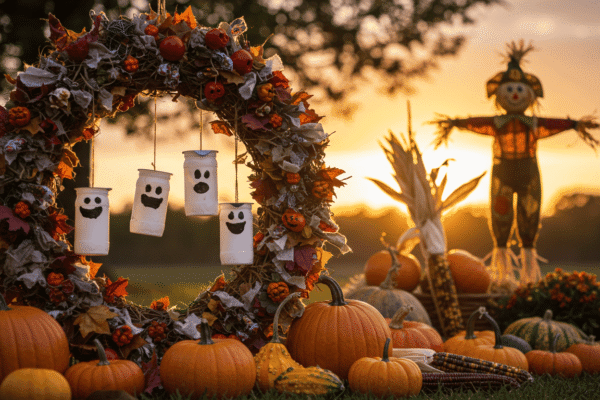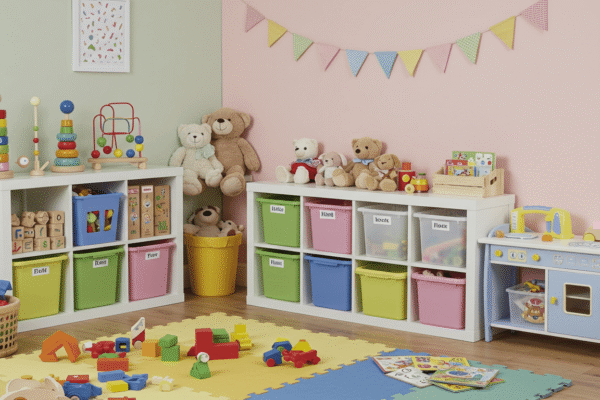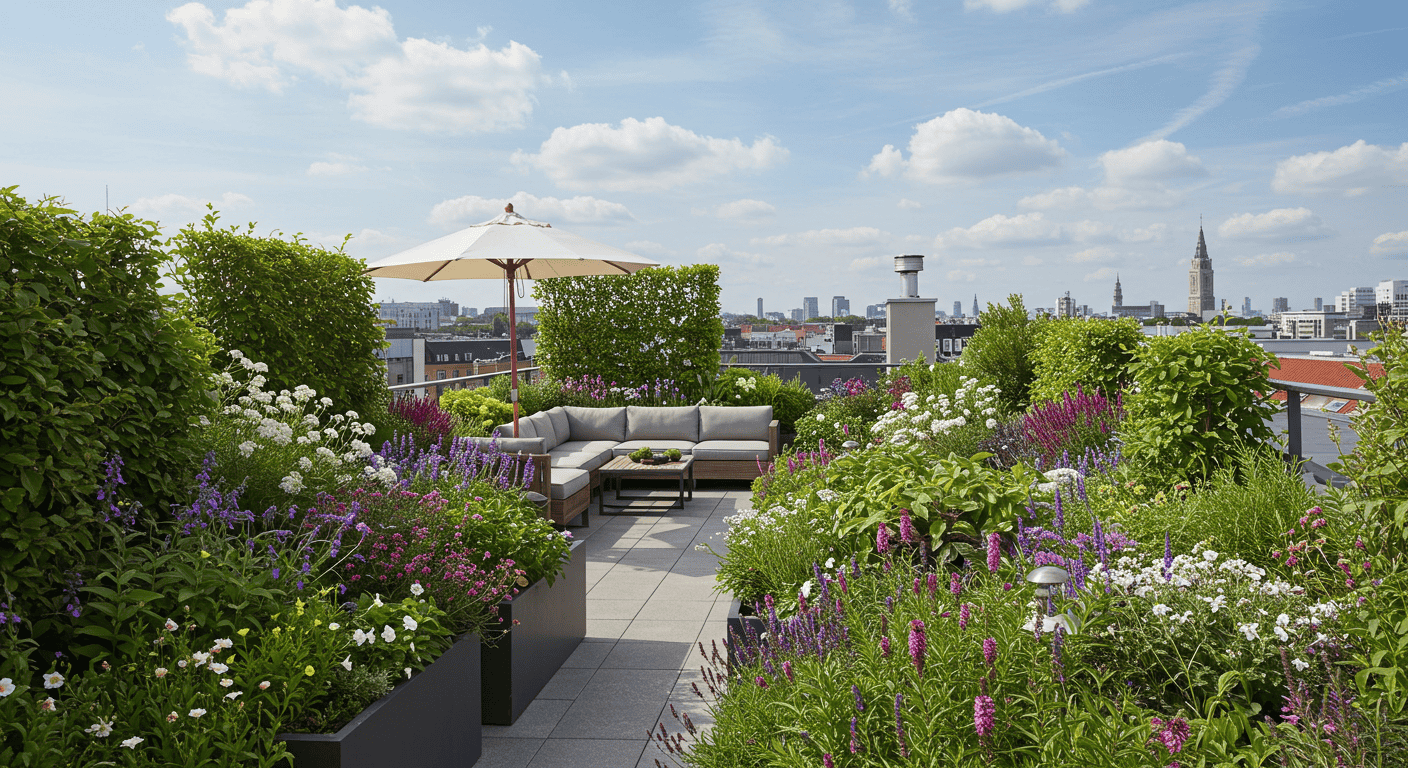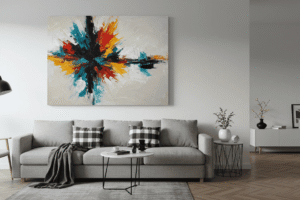Roof Garden ideas and green roofs are no longer just a luxury—they’re a creative way to transform your home into a serene, eco-friendly oasis. Whether you live in a bustling city or a suburban home, a roof garden can provide a relaxing retreat, enhance urban biodiversity, and even help save energy. In this guide, we’ll explore stunning roof garden ideas, practical tips for rooftop plants, and smart design strategies to make the most of your green roof.
1. Why a Roof Garden is the Ultimate Home Upgrade
A roof garden or green roof can completely transform the way you experience your home. Beyond its aesthetic appeal, it offers a range of benefits that improve your living space, enhance sustainability, and even contribute to environmental health. Whether you’re considering a small urban terrace or a larger rooftop, understanding the advantages of a roof garden can help you make the most informed decisions for your home.
Environmental Benefits
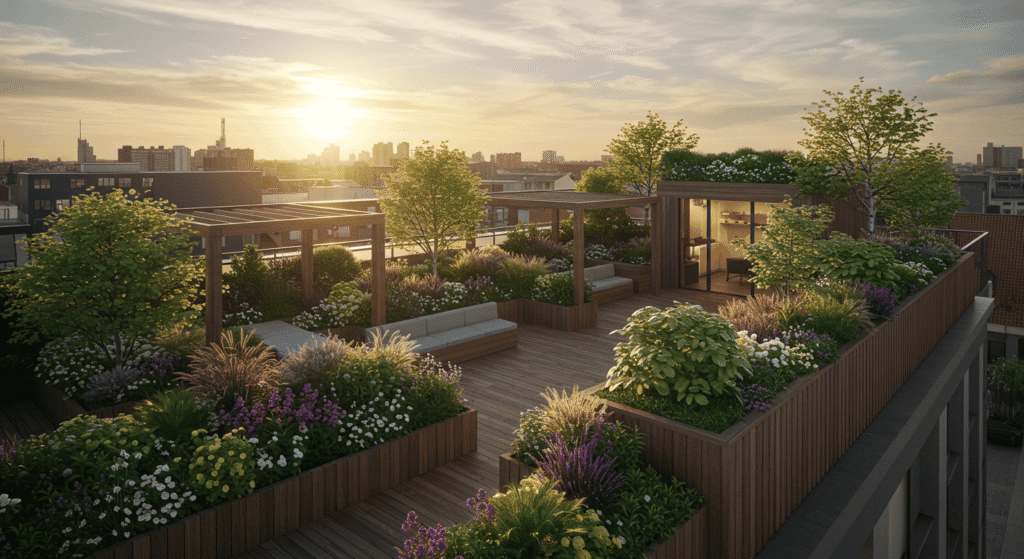
Green roofs provide a natural way to reduce your home’s environmental footprint. One key advantage is reduced heat absorption. Unlike traditional roofing materials, a roof garden absorbs less heat, keeping your home cooler during hot seasons and reducing the demand for air conditioning.
Another significant benefit is the promotion of urban biodiversity support. By planting a variety of flowers, shrubs, and even small trees, your roof garden can become a haven for birds, bees, and other pollinators, helping to restore nature in concrete-heavy urban areas.
Personal Benefits
Installing a roof garden can also enhance your quality of life on a personal level. Spending time among greenery promotes stress reduction and outdoor relaxation, providing a quiet retreat from daily routines.
Additionally, green roofs can lead to potential energy savings. The insulating properties of plants and soil reduce heat transfer into your home, lowering heating costs in winter and cooling costs in summer.
Comparative Table: Traditional Roof vs Green Roof
| Feature | Traditional Roof | Green Roof / Roof Garden |
|---|---|---|
| Cost | Lower initial cost | Moderate to high initial cost, potential long-term savings |
| Maintenance | Minimal, mostly repairs | Regular care: watering, pruning, fertilization |
| Environmental Impact | High heat absorption, no biodiversity | Reduces heat, promotes biodiversity, improves air quality |
| Energy Efficiency | Standard insulation | Better insulation, reduces heating/cooling costs |
| Aesthetic Appeal | Functional but plain | Visually appealing, relaxing outdoor space |
This table highlights why a roof garden is more than just an upgrade—it’s an investment in comfort, sustainability, and long-term home value.
2. Planning Your Roof Garden: Space, Safety, and Style
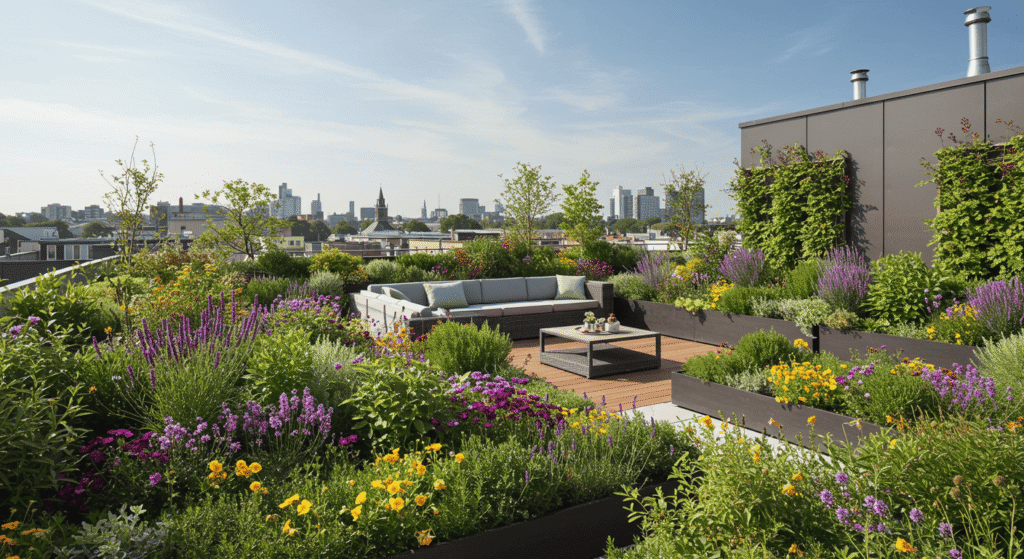
Before creating your roof garden, it’s essential to plan carefully. Good planning ensures your space is not only beautiful but also safe, functional, and long-lasting. From evaluating your roof’s strength to designing a layout that matches your lifestyle, the right approach will turn your green roof into a comfortable retreat.
Assessing Your Roof’s Load-Bearing Capacity
The first step in planning a roof garden is checking whether your roof can handle the extra weight. Soil, plants, furniture, and stored water can add up quickly, and not all roofs are designed for this kind of load. Consulting a structural engineer may be necessary to understand your roof’s limits. A lightweight soil mix, smaller containers, and careful plant choices can also help reduce stress on the structure while still giving you a vibrant green roof.
Choosing the Right Layout
Once the foundation is secure, it’s time to design your layout. An open lounge with minimal furniture creates a spacious, relaxing atmosphere, while modular planters allow flexibility and easy rearrangement as your garden grows. For compact spaces, vertical green walls are excellent for maximizing greenery without sacrificing floor area. The layout should balance aesthetics, comfort, and practicality to make your roof garden both enjoyable and easy to maintain.
Safety Tips
Safety is just as important as style when it comes to roof gardens. Installing guardrails or protective barriers keeps the area secure, especially if you plan to use it for gatherings. Choosing non-slip surfaces reduces the risk of accidents in wet conditions, while proper drainage systems prevent water buildup that could damage both plants and your roof. By combining safety measures with smart design, you can enjoy your green roof with peace of mind.
3. Choosing Plants for Your Roof Garden

Selecting the right plants is one of the most exciting steps in creating a roof garden or green roof. The ideal plant choices not only enhance beauty but also ensure your garden thrives with minimal effort. Whether you prefer a low-maintenance setup or a productive edible garden, choosing the right plants is key to a successful green roof.
Low-Maintenance Options
For those who want a vibrant roof garden without constant care, low-maintenance plants are a great choice. Succulents, ornamental grasses, and hardy shrubs are resilient, require less watering, and can survive in rooftop conditions where wind and sun exposure are more intense. These plants provide year-round greenery while keeping maintenance efforts low.
Edible Plants
If you enjoy cooking or want a more functional green roof, adding edible plants is an excellent idea. Herbs, small vegetables, and fruiting plants not only enhance the aesthetics of your roof garden but also provide fresh produce. Rooftop herbs like basil, thyme, and mint thrive in containers, while cherry tomatoes, peppers, or strawberries can add both color and flavor.
Plant Selection Table
| Plant Type | Sunlight Needs | Water Requirements | Seasonal Growth |
|---|---|---|---|
| Succulents | Full sun to partial shade | Low | Year-round |
| Ornamental Grasses | Full sun | Moderate | Spring to Fall |
| Hardy Shrubs | Full sun to partial shade | Low to moderate | Spring to Fall |
| Herbs (Basil, Thyme, Mint) | Full sun | Moderate | Spring to Fall |
| Small Vegetables (Tomatoes, Peppers) | Full sun | Moderate to high | Summer |
| Fruiting Plants (Strawberries) | Full sun | Moderate | Spring to Summer |
This table makes it easy to plan your roof garden, ensuring each plant gets the right sunlight, water, and seasonal care while creating a lush and productive green roof.
4. Small Space Roof Garden Ideas
Even if you have a limited rooftop area, a roof garden or green roof can be transformed into a beautiful and functional space. With clever design strategies, even small rooftops can provide relaxation, greenery, and a touch of nature in urban environments.
Vertical Gardening
When floor space is limited, vertical gardening is a perfect solution for a roof garden. Wall-mounted planters and hanging baskets allow you to grow a variety of plants without taking up much horizontal space. You can create a living wall of herbs, flowers, or succulents, turning even the smallest rooftop into a lush green retreat.
Multi-Functional Furniture
In a small roof garden, every element should serve multiple purposes. Storage benches doubling as planters are ideal because they combine seating with greenery. Other multi-functional pieces can include foldable tables with integrated plant sections or raised planter boxes that also act as room dividers. These designs maximize usability while keeping your green roof organized and stylish.
Maximizing Privacy
Privacy can be a concern in rooftop spaces, especially in urban areas. Using screens, trellises, and plant partitions can create a sense of seclusion in your roof garden. Climbing plants, tall shrubs, or bamboo in planters can form natural barriers, ensuring your rooftop remains a private, peaceful escape.
Table Idea: Small Space Solutions
| Feature | Option | Benefit |
|---|---|---|
| Vertical Gardening | Wall-mounted planters, hanging baskets | Saves floor space, creates lush walls |
| Multi-Functional Furniture | Storage benches with planters | Combines seating and greenery |
| Privacy | Screens, trellises, plant partitions | Provides seclusion and wind protection |
This approach ensures that even compact roof gardens are functional, beautiful, and tailored to your lifestyle.
5. Water Management and Sustainability
Proper water management is essential for a thriving roof garden or green roof. Efficient use of water not only keeps your plants healthy but also supports sustainability and reduces maintenance costs. By incorporating smart irrigation, soil solutions, and drainage systems, you can create a green roof that is both eco-friendly and easy to care for.
Rainwater Harvesting Techniques
One of the most effective ways to manage water in a roof garden is through rainwater harvesting. Collecting rainwater from your roof and storing it in barrels or tanks allows you to irrigate your plants naturally. Simple drip irrigation or soaker hoses can distribute the collected water efficiently, ensuring that your green roof stays hydrated without relying heavily on municipal water.
Soil and Drainage Solutions
Choosing the right soil and ensuring proper drainage are critical for a successful roof garden. Lightweight soil mixes reduce the overall weight on your roof while providing essential nutrients for plants. Drainage layers prevent waterlogging, which can harm roots and damage your roof structure. Combining these techniques ensures optimal plant health and longevity of your green roof.
Water-Saving Techniques Table
| Technique | Efficiency | Cost | Ease of Use |
|---|---|---|---|
| Rainwater Harvesting | High | Moderate | Moderate |
| Drip Irrigation | High | Low to Moderate | Easy |
| Soaker Hoses | Moderate | Low | Easy |
| Mulching | Moderate | Low | Easy |
| Drought-Tolerant Plants | High | Low | Easy |
This table helps you choose the right water-saving techniques for your roof garden, balancing efficiency, cost, and convenience while promoting sustainability.
6. Creative Roof Garden Design Ideas
A roof garden or green roof is not just about planting—it’s about creating a space that reflects your personality and lifestyle. By incorporating themed designs and dedicated relaxation areas, you can turn your roof garden into a unique retreat that enhances both the look and feel of your home.
Themed Roof Gardens
Themed roof gardens are an excellent way to create a cohesive and visually appealing space. A Zen garden offers minimalistic elegance with rocks, gravel, and carefully placed plants, providing a calming atmosphere. An herb garden not only adds greenery but also provides fresh ingredients for your kitchen. For a more colorful and vibrant option, a wildflower oasis attracts pollinators and creates a lively, natural environment on your green roof.
Adding Relaxation Zones
Integrating dedicated areas for relaxation is essential for a functional roof garden. Lounge areas with benches or low seating allow for social gatherings or quiet reading sessions. Hammocks provide a playful yet relaxing element, while meditation corners with minimal furniture and soft greenery create a peaceful escape. These zones transform your roof garden into more than just a visual space—they make it a lifestyle enhancement.
Lighting Ideas
Thoughtful lighting can dramatically enhance the ambiance of your roof garden. Solar lights are eco-friendly and ideal for illuminating pathways. LED strips can highlight architectural features or planters, and subtle garden lighting ensures a warm, inviting atmosphere during the evening. By combining functionality with aesthetics, lighting allows you to enjoy your green roof at any time of day.
Table Idea: Design Inspiration for Roof Gardens
| Theme | Features | Best For |
|---|---|---|
| Zen Garden | Gravel, stones, minimal plants | Relaxation and meditation |
| Herb Garden | Raised planters, aromatic herbs | Cooking and functional greenery |
| Wildflower Oasis | Seasonal flowers, pollinator-friendly | Colorful, vibrant aesthetic |
| Lounge Area | Benches, seating, tables | Social gatherings and relaxation |
| Meditation Corner | Minimal furniture, quiet spot | Personal reflection and peace |
This approach allows you to combine creativity with practicality, ensuring your roof garden is both beautiful and enjoyable.
7. Maintenance Tips for a Thriving Roof Garden
Creating a beautiful roof garden or green roof is only part of the process; regular maintenance ensures your plants remain healthy and vibrant. With proper care, your green roof can continue to flourish year after year, providing both beauty and functionality.
Seasonal Care
Seasonal attention is crucial for a thriving roof garden. Plant rotation helps maintain soil fertility and prevents overgrowth, while pruning keeps shrubs and plants healthy and aesthetically pleasing. Fertilization provides essential nutrients, ensuring that your green roof remains lush and productive throughout the year. Adjusting care routines according to the season is key to sustainable plant growth.
Pest Control Without Chemicals
Maintaining a roof garden doesn’t have to involve harsh chemicals. Using natural repellents and practicing companion planting can effectively manage pests while keeping your garden eco-friendly. For example, planting marigolds near vegetables can deter harmful insects, while attracting beneficial insects like ladybugs helps control pest populations naturally. This approach ensures your green roof stays healthy and safe for both humans and wildlife.
Seasonal Maintenance Checklist Table
| Task | Spring | Summer | Fall | Winter |
|---|---|---|---|---|
| Plant Rotation | ✓ | ✓ | ||
| Pruning | ✓ | ✓ | ✓ | |
| Fertilization | ✓ | |||
| Watering | ✓ | ✓ | ✓ | Moderate |
| Pest Control | ✓ | ✓ | ✓ | |
| Soil Health Check | ✓ | ✓ |
This seasonal maintenance checklist makes it easy to track essential tasks for your roof garden, ensuring consistent care and long-term sustainability of your green roof.
8. Transform Your Roof Garden into a Lifestyle
A roof garden or green roof can be much more than a decorative element—it can become an integral part of your daily life. By designing your green roof for social, recreational, and environmental purposes, you can enjoy long-term benefits while enhancing your home’s atmosphere.
Hosting and Entertaining
A well-planned roof garden creates an inviting space for hosting and entertaining. Outdoor dining setups, small gatherings with friends, or evening get-togethers can all be accommodated in a thoughtfully designed green roof. Adding comfortable seating, modular furniture, and ambient lighting ensures that your rooftop becomes a go-to spot for social activities.
Connecting with Nature in Urban Spaces
Even in a city, a roof garden allows you to connect with nature. Installing bird feeders attracts local wildlife, while planting pollinator-friendly plants supports bees, butterflies, and other beneficial insects. These features bring life to your green roof and help create a small but impactful urban ecosystem.
Long-Term Benefits
Investing in a roof garden delivers long-term advantages beyond aesthetics. Improved air quality and reduced heat absorption contribute to a healthier living environment, while the insulating properties of a green roof can lead to reduced energy bills. Over time, your rooftop garden becomes both an environmental asset and a valuable extension of your home.
Lifestyle Benefits Table
| Aspect | Benefit | How to Implement |
|---|---|---|
| Hosting & Entertaining | Social space, relaxation | Outdoor dining, seating, ambient lighting |
| Connecting with Nature | Supports wildlife, pollination | Bird feeders, pollinator plants |
| Long-Term Benefits | Healthier environment, energy savings | Plant selection, insulation, sustainable design |
With these strategies, your roof garden evolves from a simple rooftop feature into a functional, enjoyable, and sustainable lifestyle addition.
Conclusion: The Lasting Value of a Roof Garden
A roof garden or green roof is more than just a design trend—it’s a smart, sustainable upgrade that enhances your home and lifestyle. From lowering energy costs to creating a peaceful retreat in the heart of the city, a roof garden offers both immediate and long-term rewards. By planning carefully, choosing the right plants, and maintaining your space, you can transform your rooftop into a green haven that adds beauty, comfort, and value to your home.




